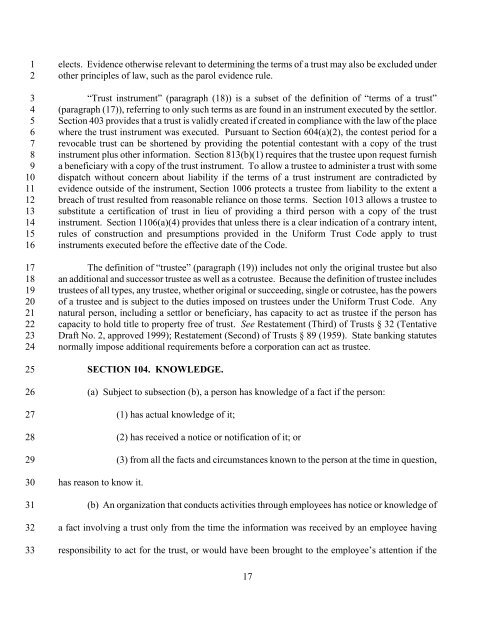uniform trust code - Kansas Judicial Branch
uniform trust code - Kansas Judicial Branch
uniform trust code - Kansas Judicial Branch
Create successful ePaper yourself
Turn your PDF publications into a flip-book with our unique Google optimized e-Paper software.
1<br />
2<br />
3<br />
4<br />
5<br />
6<br />
7<br />
8<br />
9<br />
10<br />
11<br />
12<br />
13<br />
14<br />
15<br />
16<br />
17<br />
18<br />
19<br />
20<br />
21<br />
22<br />
23<br />
24<br />
25<br />
26<br />
27<br />
28<br />
29<br />
30<br />
31<br />
32<br />
33<br />
elects. Evidence otherwise relevant to determining the terms of a <strong>trust</strong> may also be excluded under<br />
other principles of law, such as the parol evidence rule.<br />
“Trust instrument” (paragraph (18)) is a subset of the definition of “terms of a <strong>trust</strong>”<br />
(paragraph (17)), referring to only such terms as are found in an instrument executed by the settlor.<br />
Section 403 provides that a <strong>trust</strong> is validly created if created in compliance with the law of the place<br />
where the <strong>trust</strong> instrument was executed. Pursuant to Section 604(a)(2), the contest period for a<br />
revocable <strong>trust</strong> can be shortened by providing the potential contestant with a copy of the <strong>trust</strong><br />
instrument plus other information. Section 813(b)(1) requires that the <strong>trust</strong>ee upon request furnish<br />
a beneficiary with a copy of the <strong>trust</strong> instrument. To allow a <strong>trust</strong>ee to administer a <strong>trust</strong> with some<br />
dispatch without concern about liability if the terms of a <strong>trust</strong> instrument are contradicted by<br />
evidence outside of the instrument, Section 1006 protects a <strong>trust</strong>ee from liability to the extent a<br />
breach of <strong>trust</strong> resulted from reasonable reliance on those terms. Section 1013 allows a <strong>trust</strong>ee to<br />
substitute a certification of <strong>trust</strong> in lieu of providing a third person with a copy of the <strong>trust</strong><br />
instrument. Section 1106(a)(4) provides that unless there is a clear indication of a contrary intent,<br />
rules of construction and presumptions provided in the Uniform Trust Code apply to <strong>trust</strong><br />
instruments executed before the effective date of the Code.<br />
The definition of “<strong>trust</strong>ee” (paragraph (19)) includes not only the original <strong>trust</strong>ee but also<br />
an additional and successor <strong>trust</strong>ee as well as a co<strong>trust</strong>ee. Because the definition of <strong>trust</strong>ee includes<br />
<strong>trust</strong>ees of all types, any <strong>trust</strong>ee, whether original or succeeding, single or co<strong>trust</strong>ee, has the powers<br />
of a <strong>trust</strong>ee and is subject to the duties imposed on <strong>trust</strong>ees under the Uniform Trust Code. Any<br />
natural person, including a settlor or beneficiary, has capacity to act as <strong>trust</strong>ee if the person has<br />
capacity to hold title to property free of <strong>trust</strong>. See Restatement (Third) of Trusts § 32 (Tentative<br />
Draft No. 2, approved 1999); Restatement (Second) of Trusts § 89 (1959). State banking statutes<br />
normally impose additional requirements before a corporation can act as <strong>trust</strong>ee.<br />
SECTION 104. KNOWLEDGE.<br />
(a) Subject to subsection (b), a person has knowledge of a fact if the person:<br />
(1) has actual knowledge of it;<br />
(2) has received a notice or notification of it; or<br />
(3) from all the facts and circumstances known to the person at the time in question,<br />
has reason to know it.<br />
(b) An organization that conducts activities through employees has notice or knowledge of<br />
a fact involving a <strong>trust</strong> only from the time the information was received by an employee having<br />
responsibility to act for the <strong>trust</strong>, or would have been brought to the employee’s attention if the<br />
17

















